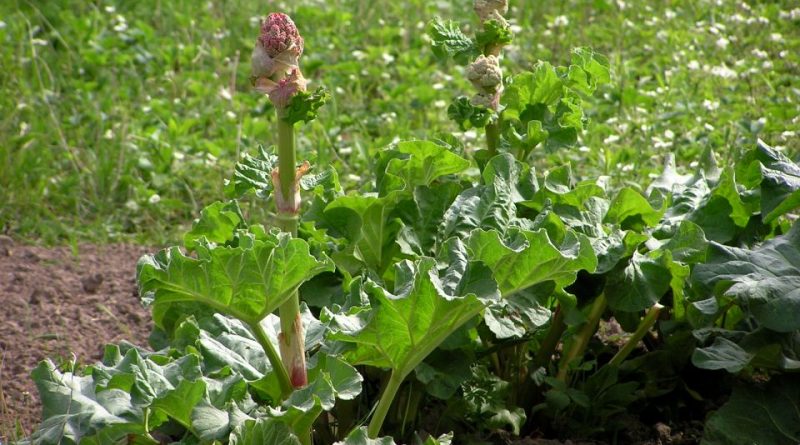Rheum rhabarbarum
Rheum rhabarbarum
Common rhubarb (Rheum rhabarbarum L.) is a herbaceous species belonging to the Polygonaceae family.
Systematics –
From a systematic point of view it belongs to:
Eukaryota Domain,
Kingdom Plantae,
Subarign Tracheobionta,
Magnoliophyta Division,
Magnoliopsida class,
Subclass Caryophyllidae,
Polygonales Order,
Polygonaceae family,
Genus Rheum,
R. rhabarbarum species.
The terms are synonymous:
– Rheum franzenbachii Münter;
– Rheum franzenbachii var. mongolium Münter;
– Rheum macropterum Mart .;
– Rheum muricatum Blanco;
– Rheum sanguineum Meisn .;
– Rheum undulatum L .;
– Rheum undulatum var. longifolium C. Y. Cheng & T. C. Kao.
Etymology –
The term Rheum comes from the root rheu; par excellence rheu barbarum root of the barbarians, from which rhubarb.
The specific epithet rhabarbarum comes from the Greek ῥα rha, contraction of ῥίζα rhiza root, and from βάρβᾰρος bárbaros exotic, foreign: exotic root.
Geographic Distribution and Habitat –
Common rhubarb is a plant native to southern Siberia, northern and central China.
It occurs naturally in an area that includes south-eastern Siberia in the region around Dauriana to the east, from Lake Baikal in Russia and northern Mongolia. In China, it is found in the northern provinces of Hebei, Heilongjiang, Henan, Hubei, Jilin, Inner Mongolia, Shanxi, and Shaanxi.
Its natural habitat in China is that of the sunny areas on the mountain slopes, from 1000 to 1600 m of altitude; in Russia it is found in the sandy soils along the edges of fields, in the steppes and in coppice woods not common at the regional level.
Description –
Rheum rhabarbarum is a perennial herbaceous plant that grows from a robust fleshy rhizome from which a new vegetative apparatus is emitted every year that can reach heights even higher than 200 cm.
The large, dark green leaves are mostly united in a basal rosette, arranged with alternating phyllotaxis, with long cylindrical and fleshy petioles and a flap that varies from ovate-cordate to kidney-shaped, simple or palmate-lobed. The margin is toothed, more or less wavy.
The flowers are bisexual, gathered in long pedunculated terminal panicles which can reach a few decimetres in length. The individual flowers have a radiated symmetry, with a perigonium made up of six white or yellowish tepals. Stamens 6 or 9 in number. Upper ovary, containing only one egg.
In China it blooms in June and bears fruit after July.
The fruit is a trigone walnut with prolonged edges in a membranous wing.
Cultivation –
Rheum rhabarbarum is a plant that has been harvested for centuries, in nature, for its root, as a use in both popular medicine in Europe and Asia. It was later cultivated for its root in some countries such as England and Russia.
Rhubarb is cultivated both as an industrial plant for the production of rhizomes, and as a vegetable plant for use for food purposes.
In both cases, the crop cycle is biennial or multi-year as in the first year the plant has a modest vigor. It is a rustic and quite adaptable plant, however it grows well in cool, moderately humid, well-endowed and well-drained soils. It prefers soils with a subacid, neutral or sub-basic reaction since it adapts to pH values ranging from 6 to 8. Exposure in full light is preferable, but it also tolerates a certain degree of shading well.
For the plant, direct sowing in the open field is not recommended, to which transplanting using one year old plants is preferred. The plants must be planted at a distance of 80-100 cm along the row and with distances between the rows according to the type of mechanization adopted. Planting takes place in November-December in mild winter areas or in February-March in cold regions.
Harvesting must be done in the second year of planting as regards the rhizome, or moderately even in the first year for the leaf petioles, taking care to leave an adequate number of leaves to allow the activity. The harvest time is autumn for the rhizome and spring, from April to June, depending on the area, for the leaves. In summer, the scapes with the inflorescences must be removed as flowering and fruiting subtract energy from the plant, penalizing above all the production of rhizomes.
Customs and Traditions –
Rheum rhabarbarum was first described by Charles Linnaeus in 1753. Linnaeus also described R. undulatum, but this is now considered the same species.
This plant has always been used for its properties. In the kitchen, cherry red stems are used, added to desserts for their intense and sweet and sour flavor, they can also be cooked in pieces, roasted or pureed and are excellent for giving flavor to dishes based on duck meat and guinea fowl. The root, harvested in autumn, has refreshing, tonic, digestive, laxative, astringent and purifying properties, has an anti-inflammatory, antifungal action, regulates bile, is useful in cases of colic, liver pain and dysentery.
Preparation Method –
The common rhubarb is used both in the medicinal field and for food purposes.
For edible use, cherry red stems are used, added to sweets for their intense and sweet and sour flavor; these can also be cooked in chunks, roasted or pureed and are great for adding flavor to various white meat dishes.
The root is harvested during the autumn period.
Guido Bissanti
Sources
– Acta Plantarum – Flora of the Italian Regions.
– Wikipedia, the free encyclopedia.
– Useful Tropical Plants Database.
– Conti F., Abbate G., Alessandrini A., Blasi C. (ed.), 2005. An annotated checklist of the Italian vascular flora, Palombi Editore.
– Pignatti S., 1982. Flora of Italy, Edagricole, Bologna.
– Treben M., 2000. Health from the Lord’s Pharmacy, Advice and experiences with medicinal herbs, Ennsthaler Editore.
Photo source:
– https://powo.science.kew.org/taxon/urn:lsid:ipni.org:names:301818-2
Warning: Pharmaceutical applications and alimurgical uses are indicated for informational purposes only, they do not represent in any way a medical prescription; therefore no responsibility is taken for their use for curative, aesthetic or food purposes.


